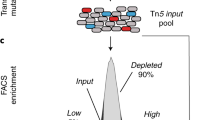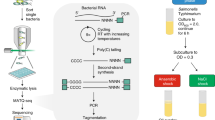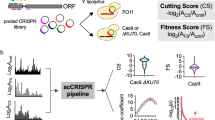Abstract
CRISPR interference (CRISPRi) is a powerful tool to link essential and nonessential genes to specific phenotypes and to explore their functions. Here we describe a protocol for CRISPRi screenings to assess genome-wide gene fitness in a single sequencing step (CRISPRi-seq). We demonstrate the use of the protocol in Streptococcus pneumoniae, an important human pathogen; however, the protocol can easily be adapted for use in other organisms. The protocol includes a pipeline for single-guide RNA library design, workflows for pooled CRISPRi library construction, growth assays and sequencing steps, a read analysis tool (2FAST2Q) and instructions for fitness quantification. We describe how to make an IPTG-inducible system with small libraries that are easy to handle and cost-effective and overcome bottleneck issues, which can be a problem when using similar, transposon mutagenesis-based methods. Ultimately, the procedure yields a fitness score per single-guide RNA target for any given growth condition. A genome-wide screening can be finished in 1 week with a constructed library. Data analysis and follow-up confirmation experiments can be completed in another 2–3 weeks.
This is a preview of subscription content, access via your institution
Access options
Access Nature and 54 other Nature Portfolio journals
Get Nature+, our best-value online-access subscription
$29.99 / 30 days
cancel any time
Subscribe to this journal
Receive 12 print issues and online access
$259.00 per year
only $21.58 per issue
Buy this article
- Purchase on Springer Link
- Instant access to full article PDF
Prices may be subject to local taxes which are calculated during checkout





Similar content being viewed by others
Data availability
Source data are provided with this paper.
Code availability
Source code for the sgRNA design and evaluation pipelines, as well as for the naïve power analysis and corresponding data, can be found at https://github.com/veeninglab/CRISPRi-seq. 2FAST2Q code, files and executables can be found at https://github.com/veeninglab/2FAST2Q, https://pypi.org/project/fast2q/ or https://doi.org/10.5281/zenodo.5079789. (Off-)target binding site tables from Liu et al.11 can be found through our website: https://www.veeninglab.com/crispri-seq.
References
Cain, A. K. et al. A decade of advances in transposon-insertion sequencing. Nat. Rev. Genet. 21, 526–540 (2020).
Qi, L. S. et al. Repurposing CRISPR as an RNA-guided platform for sequence-specific control of gene expression. Cell 152, 1173–1183 (2013).
Bikard, D. et al. Programmable repression and activation of bacterial gene expression using an engineered CRISPR-Cas system. Nucleic Acids Res. 41, 7429–7437 (2013).
Lee, H. H. et al. Functional genomics of the rapidly replicating bacterium Vibrio natriegens by CRISPRi. Nat. Microbiol. 4, 1105–1113 (2019).
Liu, X. et al. High‐throughput CRISPRi phenotyping identifies new essential genes in Streptococcus pneumoniae. Mol. Syst. Biol. 13, 931 (2017).
Wang, T. et al. Pooled CRISPR interference screening enables genome-scale functional genomics study in bacteria with superior performance. Nat. Commun. 9, 2475 (2018).
Peters, J. M. et al. A comprehensive, CRISPR-based functional analysis of essential genes in bacteria. Cell 165, 1493–1506 (2016).
Zhao, C., Shu, X. & Sun, B. Construction of a gene knockdown system based on catalytically inactive (“dead”) Cas9 (dCas9) in Staphylococcus aureus. Appl. Environ. Microbiol. 83, e00291–17 (2017).
Larson, M. H. et al. CRISPR interference (CRISPRi) for sequence-specific control of gene expression. Nat. Protoc. 8, 2180–2196 (2013).
de Wet, T. J., Winkler, K. R., Mhlanga, M., Mizrahi, V. & Warner, D. F. Arrayed CRISPRi and quantitative imaging describe the morphotypic landscape of essential mycobacterial genes. eLife 9, e60083 (2020).
Liu, X. et al. Exploration of bacterial bottlenecks and Streptococcus pneumoniae pathogenesis by CRISPRi-Seq. Cell Host Microbe 29, 107–120.e6 (2021).
de Wet, T. J., Gobe, I., Mhlanga, M. M. & Warner, D. F. CRISPRi-Seq for the identification and characterisation of essential mycobacterial genes and transcriptional units. Preprint at bioRxiv https://doi.org/10.1101/358275 (2018).
Beuter, D. et al. Selective enrichment of slow-growing bacteria in a metabolism-wide CRISPRi library with a TIMER protein. ACS Synth. Biol. 7, 2775–2782 (2018).
Yao, L. et al. Pooled CRISPRi screening of the cyanobacterium Synechocystis sp PCC 6803 for enhanced industrial phenotypes. Nat. Commun. 11, 1666 (2020).
Calvo-Villamañán, A. et al. On-target activity predictions enable improved CRISPR–dCas9 screens in bacteria. Nucleic Acids Res 48, e64 (2020).
Rousset, F. et al. Genome-wide CRISPR-dCas9 screens in E. coli identify essential genes and phage host factors. PLOS Genet 14, e1007749 (2018).
Vigouroux, A. & Bikard, D. CRISPR tools to control gene expression in bacteria. Microbiol. Mol. Biol. Rev. 84, e00077–19 (2020).
Rousset, F. & Bikard, D. CRISPR screens in the era of microbiomes. Curr. Opin. Microbiol. 57, 70–77 (2020).
Slager, J., Aprianto, R. & Veening, J.-W. Deep genome annotation of the opportunistic human pathogen Streptococcus pneumoniae D39. Nucleic Acids Res. 46, 9971–9989 (2018).
Donati, S. et al. Multi-omics analysis of CRISPRi-knockdowns identifies mechanisms that buffer decreases of enzymes in E. coli metabolism. Cell Syst. 12, 56–67.e6 (2021).
Hawkins, J. S. et al. Mismatch-CRISPRi reveals the co-varying expression–fitness relationships of essential genes in Escherichia coli and Bacillus subtilis. Cell Syst. 11, 523–535.e9 (2020).
Jiang, W., Oikonomou, P. & Tavazoie, S. Comprehensive genome-wide perturbations via CRISPR adaptation reveal complex genetics of antibiotic sensitivity. Cell 180, 1002–1017.e31 (2020).
Bosch, B. et al. Genome-wide gene expression tuning reveals diverse vulnerabilities of M. tuberculosis. Cell 184, 4579–4592.e24 (2021).
Momen-Roknabadi, A., Oikonomou, P., Zegans, M. & Tavazoie, S. An inducible CRISPR interference library for genetic interrogation of Saccharomyces cerevisiae biology. Commun. Biol. 3, 723 (2020).
Du, D. et al. Genetic interaction mapping in mammalian cells using CRISPR interference. Nat. Methods 14, 577–580 (2017).
Rock, J. M. et al. Programmable transcriptional repression in mycobacteria using an orthogonal CRISPR interference platform. Nat. Microbiol. 2, 16274 (2017).
Guzzo, M., Castro, L. K., Reisch, C. R., Guo, M. S. & Laub, M. T. A CRISPR interference system for efficient and rapid gene knockdown in Caulobacter crescentus. MBio 11, e02415–e02419 (2020).
van Opijnen, T., Bodi, K. L. & Camilli, A. Tn-seq: high-throughput parallel sequencing for fitness and genetic interaction studies in microorganisms. Nat. Methods 6, 767–772 (2009).
Hutchison, C. A. et al. Polar effects of transposon insertion into a minimal bacterial genome. J. Bacteriol. 201, e00185–19 (2019).
van Opijnen, T., Lazinski, D. W. & Camilli, A. Genome‐wide fitness and genetic interactions determined by Tn‐seq, a high‐throughput massively parallel sequencing method for microorganisms. Curr. Protoc. Mol. Biol. 106, 7.16.1–7.16.24 (2014).
van Opijnen, T. & Camilli, A. Transposon insertion sequencing: a new tool for systems-level analysis of microorganisms. Nat. Rev. Microbiol. 11, 435–442 (2013).
Yasir, M. et al. TraDIS-Xpress: a high-resolution whole-genome assay identifies novel mechanisms of triclosan action and resistance. Genome Res 30, 239–249 (2020).
Vigouroux, A., Oldewurtel, E., Cui, L., Bikard, D. & Teeffelen, S. Tuning dCas9’s ability to block transcription enables robust, noiseless knockdown of bacterial genes. Mol. Syst. Biol. 14, e7899 (2018).
Cui, L. et al. A CRISPRi screen in E. coli reveals sequence-specific toxicity of dCas9. Nat. Commun. 9, 1912 (2018).
Lawson, M. J. et al. In situ genotyping of a pooled strain library after characterizing complex phenotypes. Mol. Syst. Biol. 13, 947 (2017).
Camsund, D. et al. Time-resolved imaging-based CRISPRi screening. Nat. Methods 17, 86–92 (2020).
Shiver, A. L., Culver, R., Deutschbauer, A. M. & Huang, K. C. Rapid ordering of barcoded transposon insertion libraries of anaerobic bacteria. Nat. Protoc. 16, 3049–3071 (2021).
Baym, M., Shaket, L., Anzai, I. A., Adesina, O. & Barstow, B. Rapid construction of a whole-genome transposon insertion collection for Shewanella oneidensis by Knockout Sudoku. Nat. Commun. 7, 13270 (2016).
Zhu, L. J., Holmes, B. R., Aronin, N. & Brodsky, M. H. CRISPRseek: a Bioconductor package to identify target-specific guide RNAs for CRISPR-Cas9 genome-editing systems. PLoS One 9, e108424 (2014).
Drost, H.-G. & Paszkowski, J. Biomartr: genomic data retrieval with R. Bioinformatics 33, 1216–1217 (2017).
Blin, K., Pedersen, L. E., Weber, T. & Lee, S. Y. CRISPy-web: an online resource to design sgRNAs for CRISPR applications. Synth. Syst. Biotechnol. 1, 118–121 (2016).
Doench, J. G. et al. Optimized sgRNA design to maximize activity and minimize off-target effects of CRISPR-Cas9. Nat. Biotechnol. 34, 184–191 (2016).
Sanson, K. R. et al. Optimized libraries for CRISPR-Cas9 genetic screens with multiple modalities. Nat. Commun. 9, 5416 (2018).
van Gestel, J., Hawkins, J. S., Todor, H. & Gross, C. A. Computational pipeline for designing guide RNAs for mismatch-CRISPRi. STAR Protoc. 2, 100521 (2021).
Spoto, M., Guan, C., Fleming, E. & Oh, J. A universal, genomewide GuideFinder for CRISPR/Cas9 targeting in microbial genomes. mSphere 5, e00086–20 (2020).
Keller, L. E., Rueff, A.-S., Kurushima, J. & Veening, J.-W. Three new integration vectors and fluorescent proteins for use in the opportunistic human pathogen Streptococcus pneumoniae. Genes 10, 394 (2019).
Sorg, R. A., Kuipers, O. P. & Veening, J.-W. Gene expression platform for synthetic biology in the human pathogen Streptococcus pneumoniae. ACS Synth. Biol. 4, 228–239 (2015).
Read, A., Gao, S., Batchelor, E. & Luo, J. Flexible CRISPR library construction using parallel oligonucleotide retrieval. Nucleic Acids Res. 45, e101 (2017).
Joung, J. et al. Genome-scale CRISPR-Cas9 knockout and transcriptional activation screening. Nat. Protoc. 12, 828–863 (2017).
Bokulich, N. A. et al. Quality-filtering vastly improves diversity estimates from Illumina amplicon sequencing. Nat. Methods 10, 57–59 (2013).
Love, M. I., Huber, W. & Anders, S. Moderated estimation of fold change and dispersion for RNA-seq data with DESeq2. Genome Biol. 15, 550 (2014).
Robinson, M. D., McCarthy, D. J. & Smyth, G. K. edgeR: a Bioconductor package for differential expression analysis of digital gene expression data. Bioinformatics 26, 139–140 (2010).
Ritchie, M. E. et al. limma powers differential expression analyses for RNA-sequencing and microarray studies. Nucleic Acids Res. 43, e47 (2015).
Li, W. et al. MAGeCK enables robust identification of essential genes from genome-scale CRISPR/Cas9 knockout screens. Genome Biol. 15, 554 (2014).
Winter, J. et al. CRISPRAnalyzeR: interactive analysis, annotation and documentation of pooled CRISPR screens. Preprint at bioRxiv https://doi.org/10.1101/109967 (2017).
Whatmore, A. M., Barcus, V. A. & Dowson, C. G. Genetic diversity of the streptococcal competence (com) gene locus. J. Bacteriol. 181, 3144–3154 (1999).
Zhu, A., Ibrahim, J. G. & Love, M. I. Heavy-tailed prior distributions for sequence count data: removing the noise and preserving large differences. Bioinformatics 35, 2084–2092 (2019).
Pozzi, G. et al. Competence for genetic transformation in encapsulated strains of Streptococcus pneumoniae: two allelic variants of the peptide pheromone. J. Bacteriol. 178, 6087–6090 (1996).
Kurushima, J. et al. Unbiased homeologous recombination during pneumococcal transformation allows for multiple chromosomal integration events. eLife 9, e58771 (2020).
Sorg, R. A. et al. Collective resistance in microbial communities by intracellular antibiotic deactivation. PLOS Biol. 14, e2000631 (2016).
Acknowledgements
Work in the Veening lab is supported by the Swiss National Science Foundation (SNSF) (project grants 31003A_172861 and 310030_192517), SNSF JPIAMR grant (40AR40_185533), SNSF NCCR ‘AntiResist’ (51NF40_180541) and ERC consolidator grant 771534-PneumoCaTChER.
Author information
Authors and Affiliations
Contributions
X.L. developed the experimental procedures. V.d.B. developed the computational/analysis procedures. A.M.B. developed 2FAST2Q and the Python code for the computational pipelines. J.W.V. conceptualized this study. V.d.B. and X.L. wrote the original manuscript draft with input from A.M.B. V.d.B., X.L., A.M.B. and J.W.V. revised and edited to obtain the final manuscript.
Corresponding author
Ethics declarations
Competing interests
The authors declare no competing interests.
Additional information
Peer review information Nature Protocols thanks the anonymous reviewers for their contribution to the peer review of this work.
Publisher’s note Springer Nature remains neutral with regard to jurisdictional claims in published maps and institutional affiliations.
Related links
Key references using this protocol
Liu, X. et al. Cell Host Microbe 29, 107–120.e6 (2021): https://doi.org/10.1016/j.chom.2020.10.001
Liu, X. et al. Mol. Syst. Biol. 13, 931 (2017): https://doi.org/10.15252/msb.20167449
Key data used in this protocol
Liu, X. et al. Cell Host Microbe 29, 107–120.e6 (2021): https://doi.org/10.1016/j.chom.2020.10.001
Supplementary information
Supplementary Information
Supplementary Figs. 1–3 and Supplementary Methods.
Supplementary Software
Custom Illumina MiniSeq sequencing recipes with 54 dark cycles for both Mid and High Output Kits
Source data
Source Data Fig. 1
Statistical source data.
Source Data Fig. 3
Statistical source data.
Source Data Fig. 5
Statistical source data.
Rights and permissions
About this article
Cite this article
de Bakker, V., Liu, X., Bravo, A.M. et al. CRISPRi-seq for genome-wide fitness quantification in bacteria. Nat Protoc 17, 252–281 (2022). https://doi.org/10.1038/s41596-021-00639-6
Received:
Accepted:
Published:
Issue Date:
DOI: https://doi.org/10.1038/s41596-021-00639-6
Comments
By submitting a comment you agree to abide by our Terms and Community Guidelines. If you find something abusive or that does not comply with our terms or guidelines please flag it as inappropriate.



